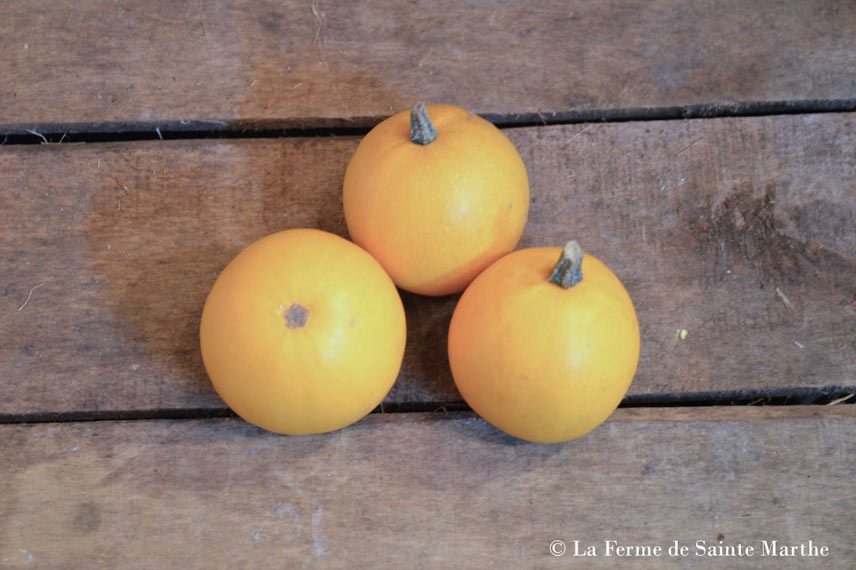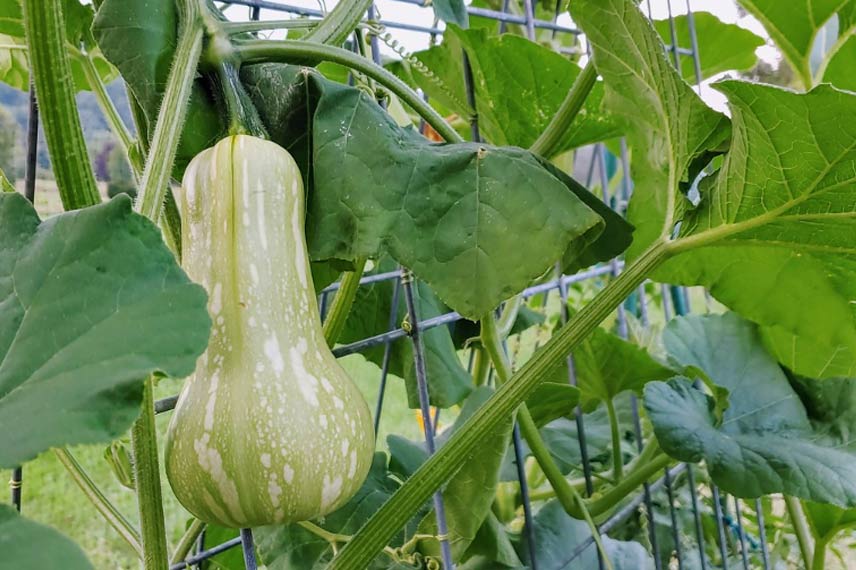Squashes and courgettes belong to Cucurbitaceae, a family of plants generally herbaceous with a creeping or climbing habit, with stems sometimes bearing tendrils. As a result, cucurbits require a lot of space to spread their extensive branching. In a small garden, don’t hesitate to trellis them to save space.
Possible varieties, supports to use, techniques... here is how to trellis squashes.
Why trellis squashes?
Vertical growing has several advantages, especially when space is limited. Thus, trellising squashes saves a considerable amount of space. Indeed, while it is generally recommended to space squash plants 2 m apart, vertical growing can reduce this spacing to 1 m or even 0.5 m.

Climbing spaghetti squashes
Moreover, this method of growing prevents fruits from remaining in constant contact with soil, improving air circulation among leaves of your cucurbits and reducing risk of disease (downy mildew, bacterial wilt, sunscald). Not to mention that while harvest is much more comfortable for you, it is conversely much harder for small animals to eat your squashes.
Finally, vertical growing limits appearance of spots and yellowing of fruits, phenomena very common with ground-grown crops.
Which squash varieties to trellis?
Among cucurbits best suited to trellising, think of vining varieties with tendrils. In addition, fruit size and weight are crucial. Abandon plan to grow the largest squashes vertically. Varieties producing fruits over 4 kg are indeed much better suited to ground culture!

Pomme d'or squashes
On the other hand, there are small squash varieties ideal for trellising, such as:
- 'Baby Boo', vining variety with tendrils that produces mini fruits of 100–300 g, 5–8 cm diameter;
- 'Pomarine', vining, productive variety yielding fruits averaging 300 g, 5–8 cm diameter;
- 'Sweet dumpling', vining variety producing fruits around 500 g, 8–15 cm diameter;
- 'Pomme d’or', vining, productive variety that yields fruits of 50–200 g, 6–8 cm diameter.
Unlike their cousins the squashes, courgettes usually lack tendrils to help them climb. It is nevertheless possible to trellis them against a support. Examples include:
- 'Shooting Star', productive variety with long fruits harvested at 15–20 cm;
- 'Zéphyr', bicolour variety with long, narrow fruits, harvested at 10–16 cm;
- or 'Black Forest', vigorous vining variety with elongated, very flavoursome fruits.
Which support to use for trellising a squash?
Galvanised sheep netting, masonry trellis, welded wire roll, rigid panel mesh... most important is to use a support strong enough to bear weight of squashes.

Musky squashes on masonry trellis ©sk - Flickr
Sheep netting can, for example, be installed along each row of squashes:
- plant stakes at base of plants;
- stretch sheep netting vertically between stakes;
- train squashes to climb this support.
You can also run squashes vertically along a wall or low wall:
- fix netting to wall using wall fastenings for mesh and rigid panels;
- or fit sturdy shelf brackets before attaching netting.
It is also possible to build an arbour:
- use hazel branches;
- construct arbour in tipi shape;
- cover structure with sheep netting.
Note: trees and free-standing hedges also make excellent supports for climbing cucurbits.
How to trellis squashes?
Equipment:
- a trellising support (see above);
- jute twine.
Technique
- In spring, enrich soil generously with compost and install support for your squashes.
- Around mid‑May, plant out your young squash plants.
- Choose a sunny spot at base of trellis.
- When squashes reach about 20 cm, insert vines gently into trellis openings (tendrils will soon take over).
- Tie vines to support with soft ties, such as jute twine, kept loose enough not to wound plant.
- Repeat as they grow, taking care to separate stems to allow air and light to reach under leaves.

Trellised cucurbits in vegetable garden ©Sharib4rd - Flickr
Warning: ensure fruits do not develop inside gaps of their trellis support.
Maintenance
- Check growth of trellised squashes regularly and adjust ties as needed.
- Make sure to water very regularly, as trellised plants tend to dry out faster.
- Apply thick layer of organic mulch at base of squashes to help retain soil moisture. As mulch decomposes it will also feed soil.
- On small plots, it is important to prune your squash plants:
- when main stem has 4–5 leaves, cut back to 2 leaves;
- after 3 weeks, when secondary stems have developed 8 leaves, cut back to 5 leaves;
- once fruits are set, cut back to 2 leaves.
For more, see all Aurélien’s tips explaining how to sow, plant, grow and harvest your squashes.
































Comments